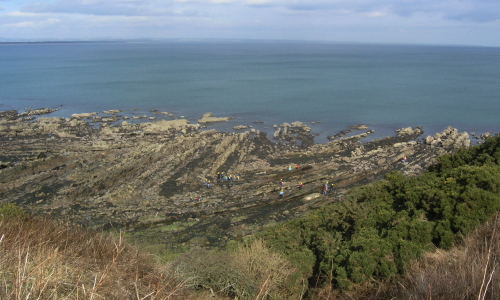![]() The theme for the next edition of the geoblogosphere’s Accretionary Wedge carnival is along the lines of “what are you doing now?” Recently as I was whining to my co-blogger about how busy my teaching was keeping me, and how I wouldn’t have time to write anything for the Wedge, Chris suggested that I exhume some navel-gazing writing I’d done a while ago and simply post that. If you would rather have seen some pretty pictures of my students on field trips, just blame Chris for this text-heavy post.
The theme for the next edition of the geoblogosphere’s Accretionary Wedge carnival is along the lines of “what are you doing now?” Recently as I was whining to my co-blogger about how busy my teaching was keeping me, and how I wouldn’t have time to write anything for the Wedge, Chris suggested that I exhume some navel-gazing writing I’d done a while ago and simply post that. If you would rather have seen some pretty pictures of my students on field trips, just blame Chris for this text-heavy post.
So, what do I do? The major theme of my research is analyzing how geologic, topographic, and land use variability controls hydrologic response, climate sensitivity, and geomorphic evolution of watersheds, by partitioning water between surface and ground water. The goal of my research is to improve reach- to landscape-scale prediction of hydrologic and geomorphic response to human activities and climate change. My work includes contributions from field studies, stable isotope analyses, time series analyses, geographic information systems, and hydrological modeling. My process-based research projects allow me to investigate complex interactions between hydrology, geomorphology, geology, and biology that occur on real landscapes, to test conceptual models about catchment functioning, and to show whether predictive models are getting the right answers for the right reasons. My current and past research has allowed me to investigate landscapes as diverse as the Cascades Range volcanic arc, the Appalachian Mountains and Piedmont of the southeastern United States, the Canadian Arctic Archipelago, and the Upper Mississippi River watershed.
In brief, my research interests look like this (thanks to TagCrowd):
More specifically, my on-going and developing research program focuses on three areas:
- Watershed influences on hydrologic response to climate variability and change;
- Controls on and effects of partitioning flowpaths between surface water and groundwater; and
- Influence of hydrologic regimes on landscape evolution and fluvial geomorphology
If you really want the long version of my research interests, venture onward. But don’t say I didn’t warn you.












Nice plan for content warnings on Mastodon and the Fediverse. Now you need a Mastodon/Fediverse button on this blog.